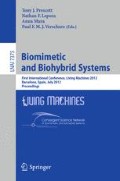Abstract
The first step for building reliable humanoid systems is to provide them with perceptual mechanisms that have human attributes, such as the skill development, social interaction, environmental embodiment and sensorial integration. Despite tactile perception being one of the most important elements for human interaction with the world, its implementation within artificial systems has been tardy, principally because it requires a complete integration with the motor systems and an environmental coupling to extract comprehensible information [1]. Thus, this work aims to generate a platform based on haptic information, allowing humanoids to perceive and represent surrounding objects using concepts fully grounded in the sensorial data.
Access this chapter
Tax calculation will be finalised at checkout
Purchases are for personal use only
References
Lederman, S.J., Klatzky, R.L.: Haptic perception: A tutorial. Attention, Perception and Psychophysics 71(7), 1439–1459 (2009)
Verschure, P.F.M.J., Voegtlin, T., Douglas, R.J.: Environmentally mediated synergy between perception and behaviour in mobile robots. Nature 425, 620–624 (2003)
Wolpert, D.M., Kawato, M.: Multiple paired forward and inverse models for motor control. Neural Networks 11(7-8), 1317–1329 (1998)
Hawkins, J., George, D., Niemasik, J.: Sequence memory for prediction, inference and behaviour. Philosophical Transactions of the Royal Society B: Biological Sciences 364(1521), 1203–1209 (2009)
Thrun, S., Burgard, W., Fox, D.: Probabilistic robotics. MIT Press (2006)
Friston, K.: The free-energy principle. A unified brain theory. Nat. Rev. Neurosci. 11(2), 127–138 (2010)
Author information
Authors and Affiliations
Editor information
Editors and Affiliations
Rights and permissions
Copyright information
© 2012 Springer-Verlag Berlin Heidelberg
About this paper
Cite this paper
Barron-Gonzalez, H., Lepora, N.F., Martinez-Hernandez, U., Evans, M., Prescott, T.J. (2012). Towards a Framework for Tactile Perception in Social Robotics. In: Prescott, T.J., Lepora, N.F., Mura, A., Verschure, P.F.M.J. (eds) Biomimetic and Biohybrid Systems. Living Machines 2012. Lecture Notes in Computer Science(), vol 7375. Springer, Berlin, Heidelberg. https://doi.org/10.1007/978-3-642-31525-1_30
Download citation
DOI: https://doi.org/10.1007/978-3-642-31525-1_30
Publisher Name: Springer, Berlin, Heidelberg
Print ISBN: 978-3-642-31524-4
Online ISBN: 978-3-642-31525-1
eBook Packages: Computer ScienceComputer Science (R0)

